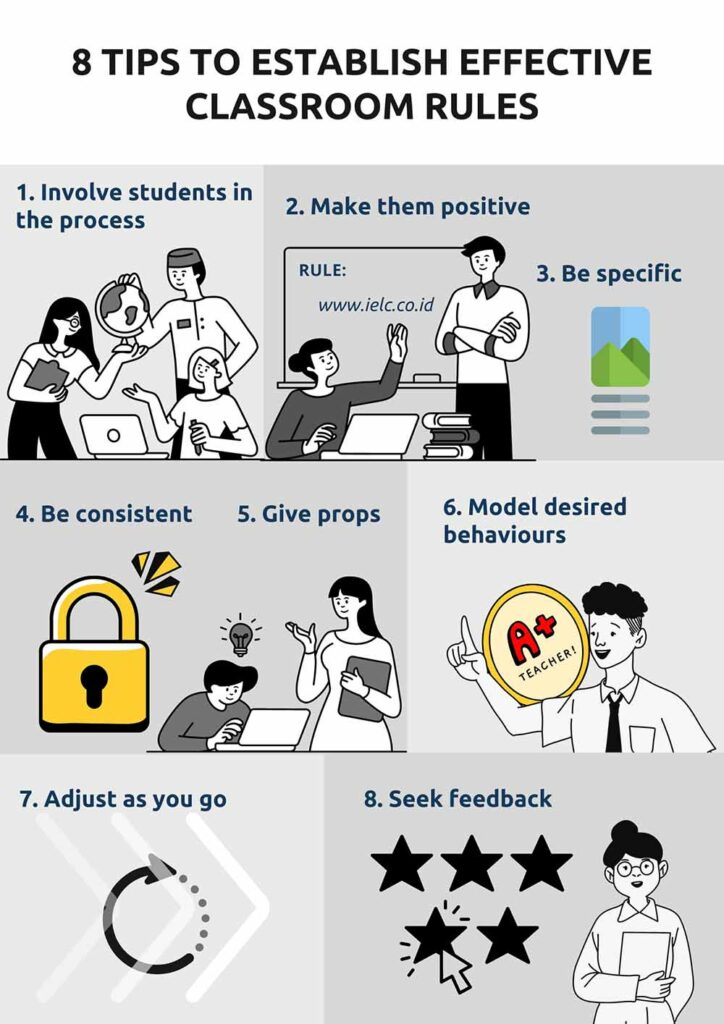
8 tips to establish effective classroom rules
Hello dedicated educators,
Every classroom is a dynamic space, bustling with diverse personalities, unique challenges, and infinite possibilities. One key aspect that can streamline this dynamic and pave the way for a harmonious learning experience is the establishment of clear and effective classroom rules.
While the content we teach varies and the teaching methodologies we employ might differ, one universal truth remains: a well-organized classroom fosters better learning. But organization isn’t just about tidy desks and a structured lesson plan; it’s about setting behavioral expectations that guide student interactions and engagements.
Creating classroom rules is more than just listing do’s and don’ts on a poster. It’s about understanding the needs of your students, recognizing potential challenges, and laying down a foundational framework that supports both academic and personal growth.
In this article, we’ll delve into the process of establishing classroom rules that are not only clear and concise but also collaborative and conducive to a thriving learning environment. Ready to get started?

1. Involve students in the process
A classroom doesn’t just belong to the teacher; it’s a shared space where every student spends a significant amount of their day. Recognizing this shared ownership, one of the most impactful ways to establish classroom rules is by involving the students in their creation.
When students actively participate in the rule-making process, the dynamic of the classroom subtly shifts. They begin to genuinely understand and respect the established guidelines, as they themselves played a pivotal role in their creation. This approach ensures that students don’t merely see the rules as external mandates but rather as logical guidelines they’ve had a hand in crafting.
This process doesn’t just produce a set of rules; it also fosters a strong classroom community. When students realize that their perspectives and opinions hold weight, it creates an inclusive environment where everyone feels valued.
As educators, our role in this process evolves. Instead of solely dictating terms, we transition to being facilitators, guiding our students in critical thinking about the kind of environment they wish to nurture and learn within!
2. Make them positive
In the intricate dance of classroom dynamics, the language we use holds immense power. It’s easy to fall into the trap of phrasing rules in negative terms, highlighting what shouldn’t be done. However, a small shift in perspective can create a more positive and constructive environment. By framing rules in positive terms, we direct the focus towards desired behaviors, offering clear guidance on what students should actively seek to do.
Take the example of classroom discussions. Telling students, “Don’t talk out of turn,” places the emphasis on the undesirable behavior. It creates an environment of restriction. On the other hand, instructing them to “Raise your hand to speak” offers a clear, actionable step for students to follow, fostering a sense of order and respect. This positive framing not only provides clarity but also encourages a proactive approach to behavior!
3. Be specific
So, imagine you’re setting up a game, but the rules sound something like, “Just play nice!” Great in spirit, but it leaves everyone scratching their heads, wondering what exactly “playing nice” means. The same goes for classroom rules. Broad rules, while sounding all noble and fancy, can sometimes be like puzzles that students have to solve.
Take “Be respectful.” It’s a golden rule we all love, right? But if you’re a student, you might be thinking, “Okay, but what does that mean here? Not poking fun at my friend? Or just listening when the teacher’s talking?” By switching it up to something more specific like, “Listen when others are speaking,” we’re making things crystal clear. No more guessing games.
When we get specific with our rules, we’re giving our students a clear playbook to follow. No more wandering around in the gray areas!
4. Be consistent
We’ve all been there – one day letting something slide, the next day being strict about it. But here’s the thing: inconsistency in enforcing classroom rules can stir up a whole lot of confusion and, let’s be honest, drama.
Think about it. If Ryan gets called out for chatting during a lesson while Vanessa gets a pass for doing the same thing the next day, we’re sending some mixed messages. And let’s not even get started on how quickly kids can spot favoritism! Before you know it, they’ll start thinking, “Why does Vanessa always get away with things?” or “Does the teacher like her more?” And bam! Trust takes a hit.
The takeaway? Once we’ve got our rules set, it’s crucial to stick to them, rain or shine. Being consistent isn’t just about keeping the peace; it’s about showing our students that every single one of them is valued and treated fairly. By staying steady and reliable, we’re laying down a foundation of trust and respect that makes the classroom a great place for everyone to learn and grow.
5. Give props when they’re due
Let’s be real: everyone, no matter their age, loves a little pat on the back for a job well done. Our classroom is no different. When students are hitting all the right notes and sticking to the rules, it’s time for us to stand up and take notice.
Remember catching your little cousin, niece, or nephew doing the right thing, and seeing their eyes light up with pride when you pointed it out? That’s the kind of magic we’re after!
So, instead of just being on the lookout for rule-breaking moments, let’s also shine a spotlight on the times our students are absolutely nailing it. By celebrating those wins, we’re telling them, “Hey, I see you doing great, and it matters!” It’s a simple switch, but boy, does it set the stage for a more upbeat and motivated classroom!
6. Model desired behaviors
Alright, here’s a nugget of wisdom: in the classroom (and, well, everywhere else), actions speak louder than words. And guess who’s center stage? Yup, that’s right, us teachers. So if we’re laying down the law about certain behaviors, we better make sure we’re living by those rules too!
Alright, real talk time: Have you ever heard that old saying, “Actions speak louder than words”? It’s a classic for a reason. As teachers, we can talk the talk, but it’s walking the walk that truly counts. Imagine laying out a rule, like attentive listening, but then zoning out when a student shares. What’s the message there? “If my teacher doesn’t bother, why should I?”
The truth is, every time we sidestep a rule we’ve set, it’s like sending a silent signal that maybe that rule isn’t so important after all. But when we lead by example, embodying the very principles we advocate, it shouts out, “This is how it’s done!” No words needed.
In a nutshell, it’s all about practicing what we preach. Because when we embody the behaviors we’re rooting for, it’s like giving our students a live-action guide on how to be classroom champs!
7. Adjust as you go
Classroom dynamics change—it’s a simple fact. What works at the start of the semester might not be as effective later on.
Starting the year, we might have a clear set of rules we believe will guide the classroom seamlessly. But as we get to know our students better and as they grow and change, we might find that some rules are no longer as relevant, or perhaps there’s a gap that needs addressing.
It’s crucial for teachers to recognize this fluidity and be willing to make adjustments. This isn’t about being indecisive; it’s about being responsive. Periodically review your rules, get feedback from students, and make changes when necessary. It’s all about ensuring the classroom remains an optimal environment for learning throughout the entire year!
8. Seek feedback
If we view the classroom as a collaborative space (and we should!), then it’s only logical that our students—our co-collaborators—have a voice in how it operates. This links back to the idea of flexibility and adaptation we discussed in rule #7. The real world doesn’t operate in a vacuum, and neither should our classrooms.
This is where feedback steps in as a powerful tool. Whether through informal chats after class or more structured anonymous surveys, asking students about the rules can provide invaluable insights. Maybe they’ll highlight a rule that isn’t clear enough, or they’ll suggest tweaks based on their daily experiences.
By routinely seeking and valuing their input, we reinforce the message that their experience in the classroom matters. It’s a continuous loop: set the rules, observe, gather feedback, and refine. This iterative process ensures our rules remain relevant, clear, and effective all year round!
Summary
Alright, educators, we’ve taken a deep dive into the world of classroom rules. From involving our students in the process to adapting rules as we go, it’s clear that this isn’t a one-size-fits-all deal. Our classrooms are alive, buzzing with unique personalities and challenges, and our rules need to keep up!
As we roll into the next academic term, let’s carry these insights with us. Let’s champion spaces that promote understanding, collaboration, and a touch of fun.
Cheers to a year of growth, shared moments, and classrooms where everyone feels at home!
At IELC, we teach English the right way
Our goal is to get you speaking in English with fluency and confidence as fast as possible. We want to give you the skills you need to fulfil your potential!
Our experienced teachers will guide you along every step of the learning process to ensure that you are not wasting your time, money, and energy on useless language exercises & wrong methods.
Our courses
With our modern campus and technology, we are equipped to provide the best possible courses for children, teens, and adults, including:
Online and on campus IELTS courses
Online and on campus TOEFL PBT courses
Online and on campus TOEFL iBT courses
We offer our classes in group classes or private classes.
No matter what your goals are, our team will help you achieve these goals by providing you with Indonesia’s best English courses!
Talk to our team today to get your FREE consultation and take your first step towards success.
Sincerely,

IELC Academic Director
